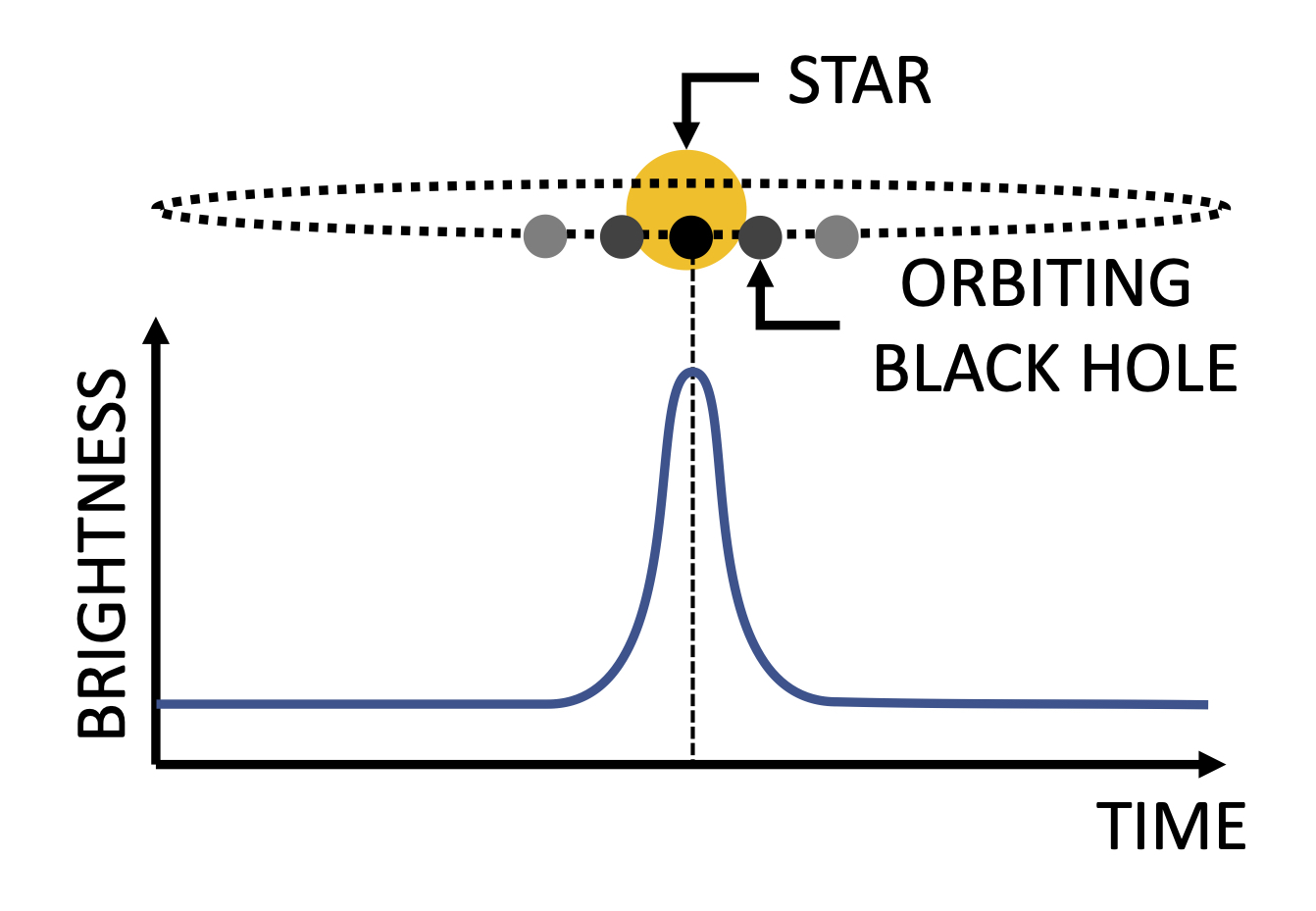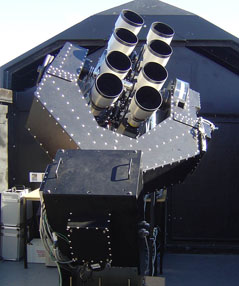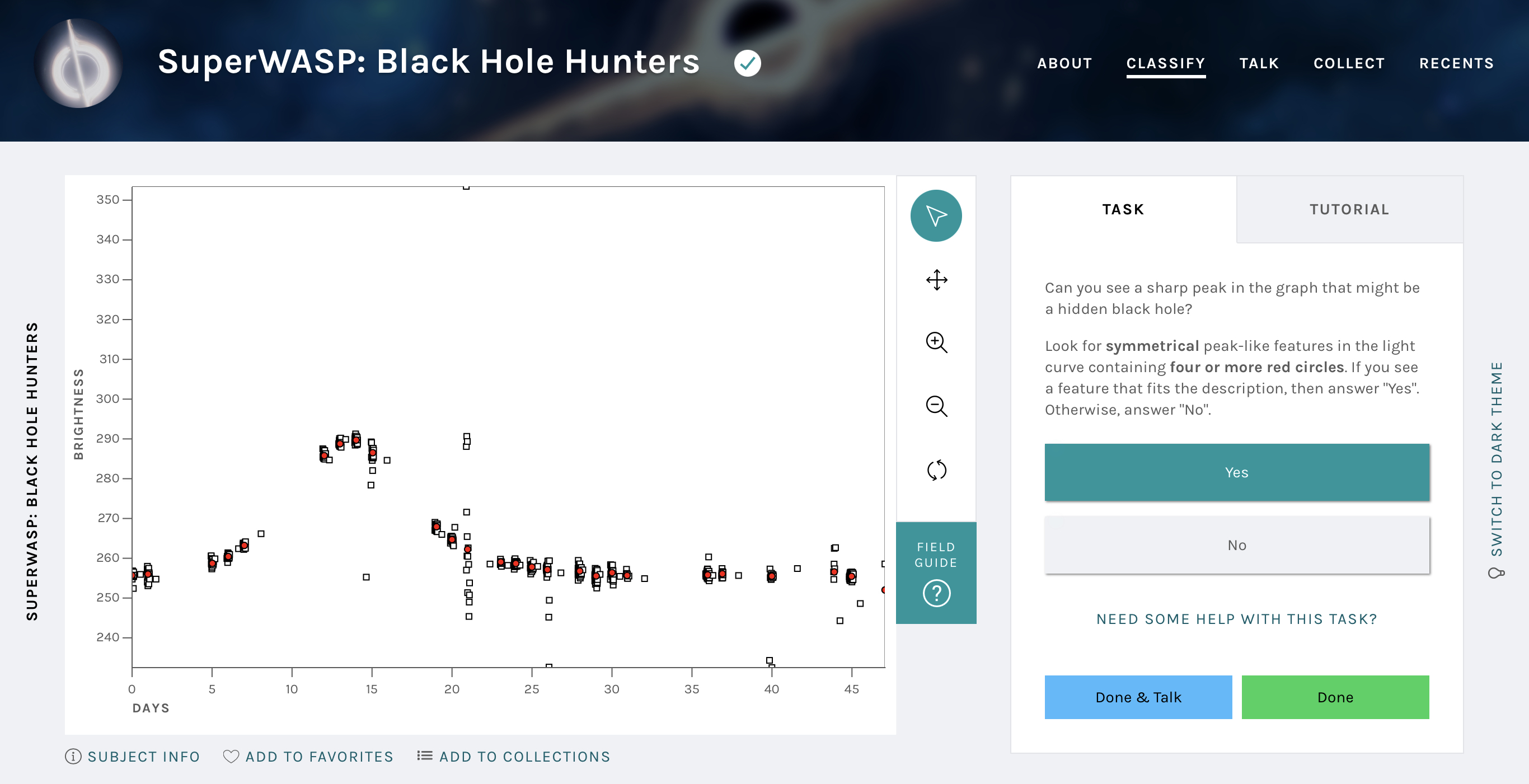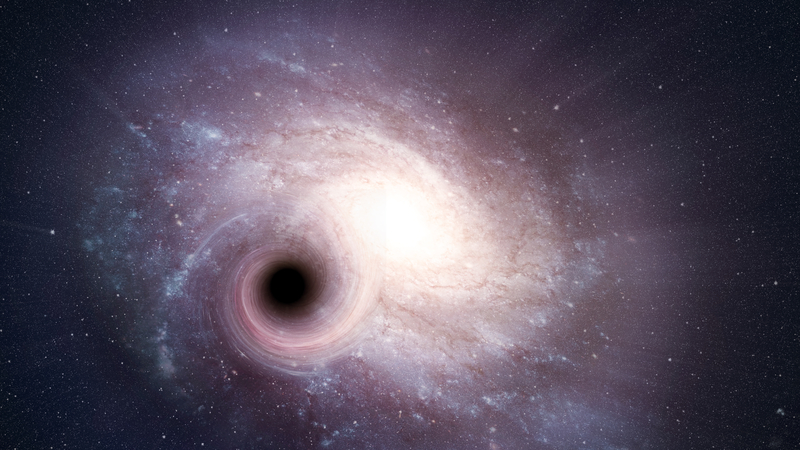Somewhere in space a black hole silently orbits a star. The star is bright enough that telescopes on Earth can view it easily, yet the black hole is invisible. Unlike many other black holes this one isn’t drawing in matter from its companion star; it’s what we call a dormant black hole. Most black holes that we detect are so close to their companions that their gravity can pull in material from the star. As this material falls towards the black hole it gets compressed and heated to extreme temperatures ̶ so hot that it emits high energy X-ray and gamma ray radiation. We can detect this radiation and that’s how we know the black hole is there.
 Figure 1: The light from a star is magnified when the black hole passes in front of it. This creates a distinctive peak in the lightcurve.
Figure 1: The light from a star is magnified when the black hole passes in front of it. This creates a distinctive peak in the lightcurve.
This black hole, however, is too far from its companion star to steal material away from it. That means there are no X-rays or gamma rays giving away its presence. It’s invisible until, one day, it gets between its companion star and the Earth. The black hole’s immensely strong gravity bends and focuses the companion star’s light into a beam pointed right at the Earth – a beam that takes thousands of years to reach us. This chance alignment – of the black hole and the star, and of the beam and the Earth – gives us the clue we need to figure out that the black hole is there. The focusing of the beam makes the star’s light appear to flare brighter than usual for a few days. This short, distinct peak in brightness is the tell-tale sign of a hidden black hole.
Finding the sudden glints of light from otherwise invisible black holes is the focus of the SuperWASP: Black Hole Hunters citizen science project. In citizen science projects, we ask volunteers – you! – for help figuring out things that computers can’t solve for us! Black Hole Hunters is the Open University’s second citizen science project using data from the SuperWASP All-Sky Survey. The first of these projects was SuperWASP Variable Stars, which is searching for regular, repeating changes in the brightness of stars.
 Figure 2: One of the two SuperWASP tele-scopes with its eight individual cameras.
Figure 2: One of the two SuperWASP tele-scopes with its eight individual cameras.
SuperWASP itself was an astronomical survey which monitored the entire sky using one telescope in the Canary Islands and one in South Africa. WASP stands for Wide-Angle Search for Planets and that is exactly what it was built for: finding planets around other stars, otherwise known as exoplanets. SuperWASP was not a citizen science project. Instead, it relied on automated algorithms, using the so-called transit method to look for dips in the brightness of stars as planets passed in front of them. Over 10 years it found almost 200 exoplanets, making it the most successful ground-based exoplanet search.
Going beyond the original design is tricky because SuperWASP was built specifically with an exoplanet search in mind. While they were very good at finding exoplanets, the telescopes and cameras weren’t built to study the stars themselves. Changes in the stars are harder to see than the dips in light from exoplanet transits. That means we can’t use automated algorithms to study stars or find black holes. Instead, we must look at the data by eye.
But there is far too much data for the scientists to study, so we turned to citizen science for help. Whereas SuperWASP Variable Stars looks for types of star that repeatedly change in brightness at regular intervals, SuperWASP: Black Hole Hunters is searching for the invisible black holes.
The two projects are very similar, except now we’re looking for stars that get brighter only once before going back to ‘normal’. The lensing effect – where the black hole’s gravity bends and focuses the light from its companion star – makes a short, symmetrical peak in the graph of the star’s brightness.
Finding invisible black holes is more of a challenge than finding variable stars, because they’re so much rarer and we only expect to see the tell-tale peak in brightness once for each black hole. If we don’t notice it the first time, there’s no second chance to find it. The peaks would eventually repeat once the black hole completes a full orbit of the star, but that can take centuries so the SuperWASP archive doesn’t cover enough time for that. Even so, the SuperWASP archive does still contain a lot of measurements of each star so the black holes are a few small needles in a very large haystack of data. This is another task that’s perfect for citizen science, since each person can just look at a small part of the data and we can ask multiple people to check each one so that we don’t miss anything.
 Figure 3: The Black Hole Hunters project on the Zooniverse.
Figure 3: The Black Hole Hunters project on the Zooniverse.
Do you want to be a black hole hunter? All you need to get started is a computer, tablet, or mobile phone. Head to Zooniverse.org and find SuperWASP Variable Stars or SuperWASP: Black Hole Hunters. Your work will directly contribute to real scientific research, and if you find something interesting, we will be sure to give you credit when we publish the results!




Rate and Review
Rate this article
Review this article
Log into OpenLearn to leave reviews and join in the conversation.
Article reviews